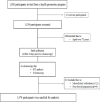The Optimal Cut-Off Level of The Fecal Immunochemical Test For Colorectal Cancer Screening in a Country with Limited Colonoscopy Resources: A Multi-Center Study from Thailand
- PMID: 28345822
- PMCID: PMC5454735
- DOI: 10.22034/APJCP.2017.18.2.405
The Optimal Cut-Off Level of The Fecal Immunochemical Test For Colorectal Cancer Screening in a Country with Limited Colonoscopy Resources: A Multi-Center Study from Thailand
Abstract
Background: Selecting the cut-off point for the fecal immunochemical test (FIT) for colorectal cancer (CRC) screening programs is of prime importance. The balance between the test performance for detecting advanced neoplasia and the available colonoscopy resources should be considered. We aimed to identify the optimal cut-off of FIT for advanced neoplasia in order to minimize colonoscopy burden. Methods: We conducted a multi-center study in 6 hospitals from diverse regions of Thailand. Asymptomatic participants, aged 50-75 years, were tested with one-time quantitative FIT (OC-SENSOR, Eiken Chemical Co.,Ltd., Tokyo, Japan) and all participants underwent colonoscopy. We assessed test performance in detecting advanced neoplasia (advanced adenoma and CRC) and measured the burden of colonoscopy with different cut-offs [25 (FIT25), 50 (FIT50), 100 (FIT100), 150 (FIT150), and 200 (FIT200)ng/ml]. Results: Among 1,479 participants, advanced neoplasia and CRC were found in 137 (9.3%) and 14 (0.9%), respectively. From FIT25 to FIT200, the positivity rate decreased from 18% to 4.9%. For advanced neoplasia, an increased cut-off decreased sensitivity from 42.3% to 16.8% but increased specificity from 84.2% to 96.3%. The increased cut-off increased the positive predictive value (PPV) from 21.5% to 31.5%. However, all cut-off points provided a high negative predictive value (NPV) (>90%). For CRC, the miss rate for FIT25 to FIT 150 was the same (n=3, 21%), whereas that with FIT200 increased to 35% (n=5). Conclusions: In a country with limited-colonoscopy resources, using FIT150 may be preferred because it offers both high PPV and NPV for advanced neoplasia detection. It could also decrease colonoscopy workload, while maintaining a CRC miss rate similar to those with lower cut-offs.
Keywords: Fecal occult blood test; colorectal cancer screening; colonoscopy.
Creative Commons Attribution License
Figures
References
-
- Alvarez-Urturi C, Andreu M, Hernandez C, et al. Impact of age- and gender-specific cut-off values for the fecal immunochemical test for hemoglobin in colorectal cancer screening. Dig Liver Dis. 2016;48:542–51. - PubMed
-
- Aniwan S, Orkoonsawat P, Viriyautsahakul V, et al. The secondary quality indicator to improve prediction of adenoma miss rate apart from adenoma detection rate. Am J Gastroenterol. 2016;111:723–9. - PubMed
-
- Aniwan S, Rerknimitr R, Kongkam P, et al. A combination of clinical risk stratification and fecal immunochemical test results to prioritize colonoscopy screening in asymptomatic participants. Gastrointest Endosc. 2015;81:719–27. - PubMed
-
- Brenner H, Haug U, Hundt S. Inter-test agreement and quantitative cross-validation of immunochromatographical fecal occult blood tests. Int J Cancer. 2010;127:1643–9. - PubMed
-
- Brenner H, Tao S. Superior diagnostic performance of faecal immunochemical tests for haemoglobin in a head-to-head comparison with guaiac based faecal occult blood test among 2235 participants of screening colonoscopy. Eur J Cancer. 2013;49:3049–54. - PubMed





